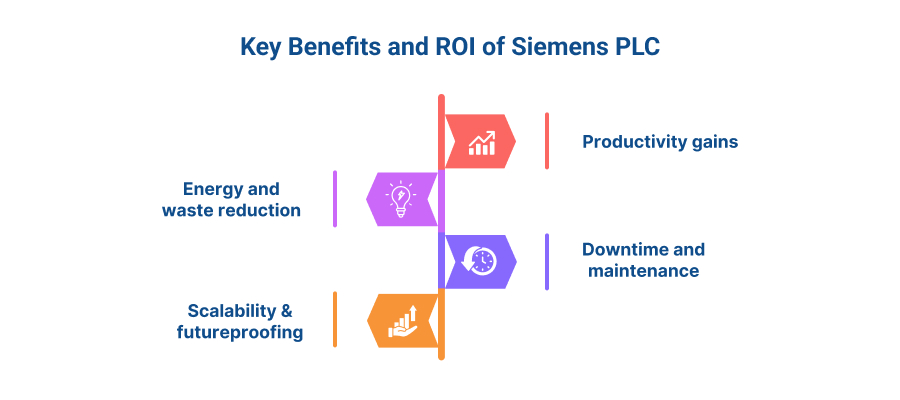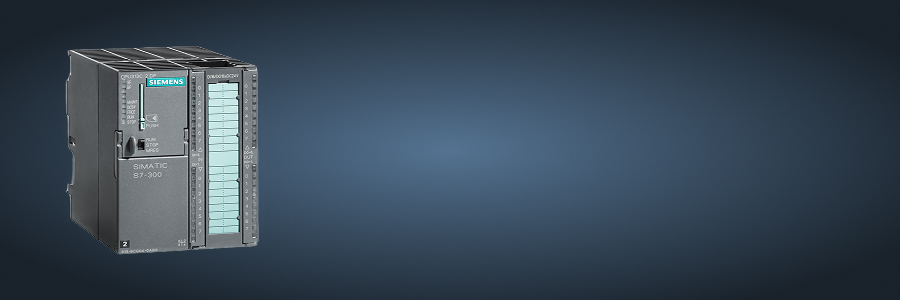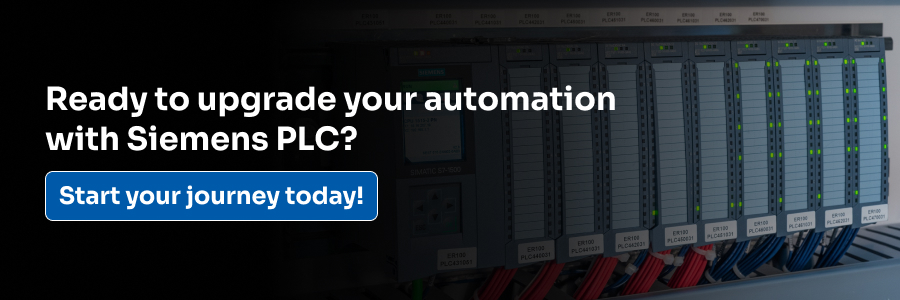TL; DR:
- Being robust and versatile, the SIMATIC PLC series from Siemens leads the automation market.
- In different industries in India, including automotive and pharma, the plants are getting modernized with Siemens PLC: for example, MG Motor India used SIMATIC controllers and IoT analytics to increase paint-shop throughput by 15%, and Cipla’s continuous API plant reduced waste and energy consumption through SIMATIC PCS 7 (PLC-based) controls.
- These enhancements provide clear ROI through increase in productivity, reduction in downtime, and cost savings. (Naksh Technology Solutions LLP can help Indian manufacturers implement such solutions.)
Why Siemens PLC Controllers?
- Market leader with broad support: Siemens SIMATIC PLCs (e.g. the S7‑1200 and S7‑1500 series) hold a large market share in industrial automation. Their global presence and service network (including in India) ensure reliable support for users.
- Modular and versatile: These SIMATIC PLCs offer hardware scalability (from compact to high-end CPUs) that meet various applications. They are easily integrated via the TIA Portal and support IIoT (Industrial Internet of Things) for advanced analytics and remote monitoring.
- Reputation for reliability: These controllers resist all attempts to degrade them in harsh industrial environments. Siemens PLC hardware and software provide diagnostics, safety systems that reduce downtime, and other quality features. It is on account of this attention to quality that Siemens is “generally considered the best PLC manufacturer.”
Industry Case Studies & ROI
Siemens SIMATIC PLCs and Analytics at MG Motor India. In Gujarat, MG Motor Plant integrated data from SIMATIC PLCs into Siemens Insights Hub and Plant Simulation, allowing engineers to identify bottlenecks in the process and increase paint-shop throughput by 15% (Legacy PLCs on their own could not provide such insight). Thus, this example clearly shows that retrofitting or upgrading with modern Siemens PLC and software yields measurable ROIs.
- Cipla Ltd (Pharma): Cipla’s API plant in Kurkumbh now uses a Siemens SIMATIC PCS 7 control system (built on SIMATIC PLCs) for continuous manufacturing. This new automation “saves time, reduces wastage, lowers energy and utility requirements, increases safety, and ensures better quality”. In other words, the Siemens-based solution greatly cut costs and boosted output quality.
- Carlsberg (Beverage): In a brewing plant, Siemens helped Carlsberg automate data capture from PLCs and SCADA systems. The result was “enhance brewing efficiency and quality” through real-time data integration. (While not an Indian company, this reference shows the global impact of Siemens PLC solutions in manufacturing.)
- Other Sectors: Indian textiles, chemicals, and food processors similarly benefit. Upgrading to SIMATIC S7 PLCs often yields faster cycle times and lower energy use (by enabling VFD control and smart drives). Overall, customers report better OEE (overall equipment effectiveness) and ROI when Siemens PLC replaces older controllers or manual systems.
Learn how Siemens PLC empowers packaging and textile plants with seamless automation, improved productivity, and reduced downtime.
Key Benefits and ROI of Siemens PLC

- Productivity gains: Modern Siemens PLC imply better control and automation. A typical example is MG Motor gaining a 15% abundance increment owing to the usage of SIMATIC PLC data. Manufacturers attest that automatic control loops and sequencing eliminate manual delays and pay investments back overnight.
- Energy and waste reduction: Advanced control logics and integration with variable-speed drives can bring great savings. Through the case of Cipla, Siemens automation brought down energy and waste. Many units report about 10–20% energy savings after upgrading their drives and PLCs (as per industry reports).
- Downtime and maintenance: The PLCs with built-in diagnostics cut the repair times. Siemens PLC can issue alerts or move the plant/process to safe states automatically, lessening unplanned downtimes. A time-saving feature is the remote monitoring of PLC status through IoT gateways, allowing for quicker troubleshooting. Less stopping means more ROI, which means more ROI.
- Scalability & futureproofing: Siemens PLCs have seamless integration with HMIs, SCADA, and MES systems alike. Companies save engineering costs by code reuse in TIA Portal from one machine to another. Also, upgrades (e.g., from S7‑300 to S7‑1500) usually require an exceptionally low level of rework, thereby making the initial investment much safer.
Conclusion
The Indian industry is well served and powered by the widespread use of Siemens SIMATIC PLCs. Robust hardware from Siemens, along with modern software integration and local support, yields measurable results in industries: improving efficiency, safety, and quality, as cited in the examples of MG Motor and Cipla. Manufacturers aiming to modernize their operations can earn the ROI benefits through collaboration with the experts.
Naksh Technology Solutions LLP, a certified Siemens automation partner, can help Indian companies select and deploy the appropriate SIMATIC PLC-based solutions for optimal performance. With Siemens PLC technology backed by local knowledge, Indian industries can ramp up productivity and maintain their competitive edge.
FAQs Related to Siemens PLC:
Q.1 What industries use Siemens PLC controllers?
Ans: Siemens SIMATIC PLCs are used across industries like automotive, pharma, food & beverage, textiles, chemicals, packaging, and oil & gas. Examples include MG Motor India, Cipla, and Carlsberg, proving their wide applicability for precise control, data logging, and high uptime.
Q.2 How do Siemens PLCs improve ROI for factories?
Ans: Siemens PLCs boost ROI by increasing output, cutting waste, and reducing downtime. For example, MG Motor India saw 15% higher throughput, while Cipla cut energy use. Features like predictive maintenance, fast commissioning, and easy troubleshooting further enhance savings.
Q.3. Why choose Siemens PLC controllers?
Ans. Siemens SIMATIC PLCs are trusted for their performance, easy integration, and global support. With TIA Portal, they simplify programming, diagnostics, and IoT connectivity. Their wide product range and reliability help manufacturers reduce risk, speed up development, and achieve strong ROI.

